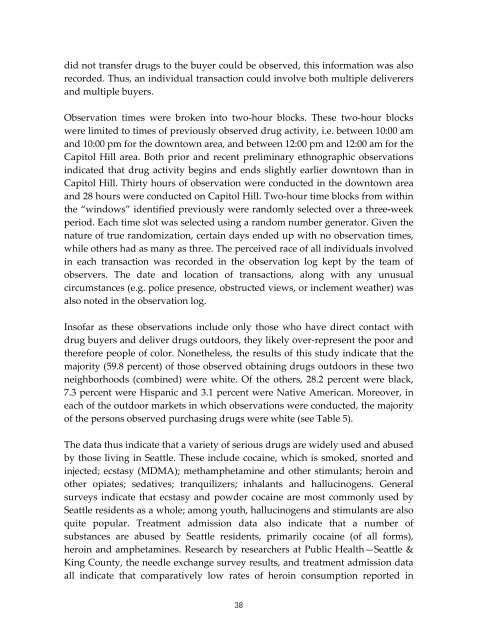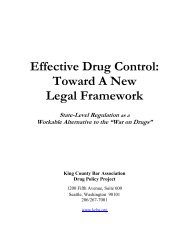RACE AND THE ENFORCEMENT OF DRUG DELIVERY LAWS IN ...
RACE AND THE ENFORCEMENT OF DRUG DELIVERY LAWS IN ...
RACE AND THE ENFORCEMENT OF DRUG DELIVERY LAWS IN ...
Create successful ePaper yourself
Turn your PDF publications into a flip-book with our unique Google optimized e-Paper software.
did not transfer drugs to the buyer could be observed, this information was also<br />
recorded. Thus, an individual transaction could involve both multiple deliverers<br />
and multiple buyers.<br />
Observation times were broken into two-hour blocks. These two-hour blocks<br />
were limited to times of previously observed drug activity, i.e. between 10:00 am<br />
and 10:00 pm for the downtown area, and between 12:00 pm and 12:00 am for the<br />
Capitol Hill area. Both prior and recent preliminary ethnographic observations<br />
indicated that drug activity begins and ends slightly earlier downtown than in<br />
Capitol Hill. Thirty hours of observation were conducted in the downtown area<br />
and 28 hours were conducted on Capitol Hill. Two-hour time blocks from within<br />
the “windows” identified previously were randomly selected over a three-week<br />
period. Each time slot was selected using a random number generator. Given the<br />
nature of true randomization, certain days ended up with no observation times,<br />
while others had as many as three. The perceived race of all individuals involved<br />
in each transaction was recorded in the observation log kept by the team of<br />
observers. The date and location of transactions, along with any unusual<br />
circumstances (e.g. police presence, obstructed views, or inclement weather) was<br />
also noted in the observation log.<br />
Insofar as these observations include only those who have direct contact with<br />
drug buyers and deliver drugs outdoors, they likely over-represent the poor and<br />
therefore people of color. Nonetheless, the results of this study indicate that the<br />
majority (59.8 percent) of those observed obtaining drugs outdoors in these two<br />
neighborhoods (combined) were white. Of the others, 28.2 percent were black,<br />
7.3 percent were Hispanic and 3.1 percent were Native American. Moreover, in<br />
each of the outdoor markets in which observations were conducted, the majority<br />
of the persons observed purchasing drugs were white (see Table 5).<br />
The data thus indicate that a variety of serious drugs are widely used and abused<br />
by those living in Seattle. These include cocaine, which is smoked, snorted and<br />
injected; ecstasy (MDMA); methamphetamine and other stimulants; heroin and<br />
other opiates; sedatives; tranquilizers; inhalants and hallucinogens. General<br />
surveys indicate that ecstasy and powder cocaine are most commonly used by<br />
Seattle residents as a whole; among youth, hallucinogens and stimulants are also<br />
quite popular. Treatment admission data also indicate that a number of<br />
substances are abused by Seattle residents, primarily cocaine (of all forms),<br />
heroin and amphetamines. Research by researchers at Public Health—Seattle &<br />
King County, the needle exchange survey results, and treatment admission data<br />
all indicate that comparatively low rates of heroin consumption reported in<br />
38

















